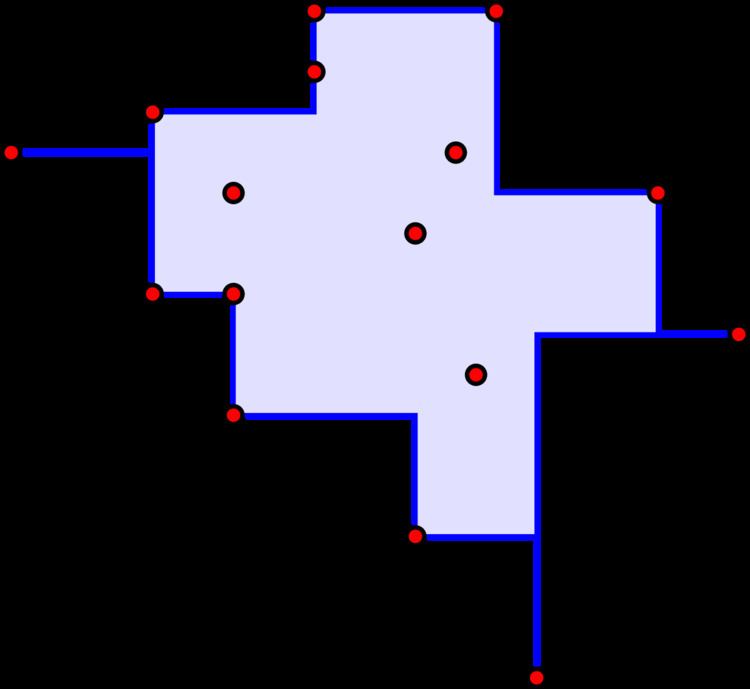 | ||
In metric geometry, the metric envelope or tight span of a metric space M is an injective metric space into which M can be embedded. In some sense it consists of all points "between" the points of M, analogous to the convex hull of a point set in a Euclidean space. The tight span is also sometimes known as the injective envelope or hyperconvex hull of M. It has also been called the injective hull, but should not be confused with the injective hull of a module in algebra, a concept with a similar description relative to the category of R-modules rather than metric spaces.
Contents
The tight span was first described by Isbell (1964), and it was studied and applied by Holsztyński in the 1960s. It was later independently rediscovered by Dress (1984) and Chrobak & Larmore (1994); see Chepoi (1997) for this history. The tight span is one of the central constructions of T-theory.
Definition
The tight span of a finite metric space can be defined as follows. Let (X,d) be a metric space, with X finite, and let T(X) be the set of functions f from X to R such that
- For any x, y in X, f(x) + f(y) ≥ d(x,y), and
- For each x in X, there exists y in X such that f(x) + f(y) = d(x,y).
In particular (taking x = y in property 1 above) f(x) ≥ 0 for all x. One way to interpret the first requirement above is that f defines a set of possible distances from some new point to the points in X that must satisfy the triangle inequality together with the distances in (X,d). The second requirement states that none of these distances can be reduced without violating the triangle inequality.
Given two functions f and g in T(X), define δ(f,g) = max |f(x)-g(x)|; if we view T(X) as a subset of a vector space R|X| then this is the usual L∞ distance between vectors. The tight span of X is the metric space (T(X),δ). There is an isometric embedding of X into its tight span, given by mapping any x into the function fx(y) = d(x,y). It is straightforward to expand the definition of δ using the triangle inequality for X to show that the distance between any two points of X is equal to the distance between the corresponding points in the tight span.
The definition above embeds the tight span of a set of n points into a space of dimension n. However, Develin (2006) showed that, with a suitable general position assumption on the metric, this definition leads to a space with dimension between n/3 and n/2. Develin & Sturmfels (2004) attempted to provide an alternative definition of the tight span of a finite metric space, as the tropical convex hull of the vectors of distances from each point to each other point in the space. However, later the same year they acknowledged in an Erratum Develin & Sturmfels (2004a) that, while the tropical convex hull always contains the tight span, it may not coincide with it.
For general (finite and infinite) metric spaces, the tight span may be defined using a modified version of property 2 in the definition above stating that inf f(x) + f(y) - d(x,y) = 0. An alternative definition based on the notion of a metric space aimed at its subspace was described by Holsztyński (1968), who proved that the injective envelope of a Banach space, in the category of Banach spaces, coincides (after forgetting the linear structure) with the tight span. This theorem allows to reduce certain problems from arbitrary Banach spaces to Banach spaces of the form C(X), where X is a compact space.
Example
The figure shows a set X of 16 points in the plane; to form a finite metric space from these points, we use the Manhattan distance (L1 metric). The blue region shown in the figure is the orthogonal convex hull, the set of points z such that each of the four closed quadrants with z as apex contains a point of X. Any such point z corresponds to a point of the tight span: the function f(x) corresponding to a point z is f(x) = d(z,x). A function of this form satisfies property 1 of the tight span for any z in the Manhattan-metric plane, by the triangle inequality for the Manhattan metric. To show property 2 of the tight span, consider some point x in X; we must find y in X such that f(x)+f(y)=d(x,y). But if x is in one of the four quadrants having z as apex, y can be taken as any point in the opposite quadrant, so property 2 is satisfied as well. Conversely it can be shown that every point of the tight span corresponds in this way to a point in the orthogonal convex hull of these points. However, for point sets with the Manhattan metric in higher dimensions, and for planar point sets with disconnected orthogonal hulls, the tight span differs from the orthogonal convex hull.
